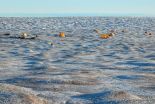(Press-News.org) Scientists at the University of Southampton have discovered that a region on the front surface of the eye harbours special stem cells that could treat blinding eye conditions.
This part of the eye is called the 'corneal limbus' and is a narrow gap lying between the transparent cornea and white sclera.
The research, published in PLOS ONE, showed that stem cells can be cultured from the corneal limbus in vitro. Under the correct culture conditions, these cells could be directed to behave like the cells needed to see light - photoreceptor cells.
The loss of photoreceptors cells causes irreversible blindness and researchers hope that this discovery could lead to new treatments for conditions such as age related macular degeneration, the leading cause of blindness in the developed world which affects around one in three people in the UK by age of 75.
Professor Andrew Lotery, of the University of Southampton and a Consultant Ophthalmologist at Southampton General Hospital led the study. He comments: "These cells are readily accessible, and they have surprising plasticity, which makes them an attractive cell resource for future therapies. This would help avoid complications with rejection or contamination because the cells taken from the eye would be returned to the same patient. More research is now needed to develop this approach before these cells are used in patients."
Furthermore, these stem cells also exist in aged human eyes, and can be cultured even from the corneal limbus of 97 year olds. Therefore this discovery opens up the possibility of new treatments for the older generations, researchers believe.
INFORMATION:
The research was funded by the National Eye Research Centre (NERC), Rosetrees Trust, T.F.C. Frost Charity and the Gift of Sight Appeal.
Stem cell discovery could lead to better treatments for blindness
2014-10-01
ELSE PRESS RELEASES FROM THIS DATE:
Predictor of tissue injury in kidney transplant recipients found
2014-10-01
Researchers at UC San Francisco and Rush University Medical Center, Chicago, may have found a predictor for a disorder affecting kidney transplant recipients that can accelerate organ failure, a discovery that eventually could allow for customized therapies and improved patient selection for transplant.
The study of focal segmental glomerulosclerosis (FSGS), a devastating form of kidney disease, is in the Oct. 1 issue of Science Translational Medicine. Research was conducted by an international study team, with Necker Hospital in Paris and UCSF joint lead authors and ...
Researchers find promise in new treatments for GBM
2014-10-01
(Boston) — Glioblastma multiforme (GBM) is one of the most lethal primary brain tumors, with median survival for these patients only slightly over one year. Researchers at Boston University School of Medicine (BUSM), in collaboration with researchers from the City of Hope, are looking toward novel therapeutic strategies for the treatment of GBM in the form of targeted therapies against a unique receptor, the interleukin-13 receptor α chain variant 2 (IL13Rα2).
In a review paper published in the October issue of Neuro-Oncology, the researchers discuss various ...
Team advances understanding of the Greenland Ice Sheet's meltwater channels
2014-10-01
An international research team's field work, drilling and measuring melt rates and ice sheet movement in Greenland is showing that things are, in fact, more complicated than we thought.
"Although the Greenland Ice Sheet initially speeds up each summer in its slow-motion race to the sea, the network of meltwater channels beneath the sheet is not necessarily forming the slushy racetrack that had been previously considered," said Matthew Hoffman, a Los Alamos National Laboratory scientist on the project.
A high-profile paper appearing in Nature this week notes that observations ...
NASA sees intensifying typhoon Phanfone heading toward Japan
2014-10-01
VIDEO:
NASA's TRMM satellite saw Phanfone was producing rainfall over a very large area on Oct. 1. Some storms in these bands were dropping rain at a rate of over 76...
Click here for more information.
An intensifying typhoon called Phanfone that originated east of Guam on September 28, 2014 is headed toward southern Japan. The TRMM satellite crossed above Typhoon Phanfone on October 1, 2014 at 1039 UTC and gathered data about rainfall rates occurring in the storm.
TRMM, ...
Genetic secrets of the monarch butterfly revealed
2014-10-01
The monarch butterfly is one of the most iconic insects in the world, best known for its distinct orange and black wings and a spectacular annual mass migration across North America. However, little has been known about the genes that underlie these famous traits, even as the insect's storied migration appears to be in peril.
Sequencing the genomes of monarch butterflies from around the world, a team of scientists has now made surprising new insights into the monarch's genetics. They identified a single gene that appears central to migration – a behavior generally regarded ...
Gut bacteria are protected by host during illness
2014-10-01
To protect their gut microbes during illness, sick mice produce specialized sugars in the gut that feed their microbiota and maintain a healthy microbial balance. This protective mechanism also appears to help resist or tolerate additional harmful pathogens, and its disruption may play a role in human diseases such as Crohn's disease, report scientists from the University of Chicago in Nature on Oct 1.
"Both hosts and their gut microbiota can suffer in the case of sickness, but this mutually beneficial relationship is guarded by the host," said study senior author Alexander ...
New study explains wintertime ozone pollution in Utah oil and gas fields
2014-10-01
Chemicals released into the air by oil and gas exploration, extraction and related activities can spark reactions that lead to high levels of ozone in wintertime, high enough to exceed federal health standards, according to new NOAA-led research, published today in Nature.
The study comes at a time when new technologies are helping to accelerate oil and gas development in Utah's Uintah Basin, elsewhere in the United States and in many other countries, and its findings may help air quality managers determine how to best minimize the impact of ozone pollution.
When ozone ...
Evolving plumbing system beneath Greenland slows ice sheet as summer progresses
2014-10-01
AUSTIN, Texas—A team led by scientists at the University of Texas at Austin's Institute for Geophysics has for the first time directly observed multiple parts of Greenland's subglacial plumbing system and how that system evolves each summer to slow down the ice sheet's movement toward the sea.
These new observations could be important in accurately modeling Greenland's future response to climate change.
"Everyone wants to know what's happening under Greenland as it experiences more and more melt," said study coauthor Ginny Catania, a research scientist at the institute ...
Winter is coming ... to Titan's south pole
2014-10-01
Titan is unique in our solar system because of its dense nitrogen-methane atmosphere, which is very similar to Earth's in some ways, but very different in others. For example, air temperatures are around 200 degrees colder and, in contrast to the warm salt water seas of Earth, frigid hydrocarbon lakes populate Titan's surface.
Titan has seasons just like Earth, only each season lasts over seven years instead of three months due to its ponderous orbit around the Sun. After equinox in 2009, Titan's south pole entered the perpetual darkness of polar winter. Soon after, ...
Solving the mystery of the 'man in the moon'
2014-10-01
New data obtained by NASA's GRAIL mission reveals that the Procellarum region on the near side of the moon — a giant basin often referred to as the "man in the moon" — likely arose not from a massive asteroid strike, but from a large plume of magma deep within the moon's interior.
The Procellarum region is a roughly circular, volcanic terrain some 1,800 miles in diameter — nearly as wide as the United States. One hypothesis suggested that it was formed by a massive impact, in which case it would have been the largest impact basin on the moon. Subsequent asteroid collisions ...



